Artistic movements pass through several stages. First, one finds brave experimenters, those who stretch the envelope to its limits, hoping that it will break asunder. But for movements to develop and to enlarge, practitioners must be more than bad boys. They must incorporate what is best of the new with what is best from the tradition. Novelty must become establishment. Over the past half-dozen years, at El Bulli, at Alinea, at Moto, at WD-50, each in their own way, the experimentalists have been developing what has variously been called microscopic cuisine, sci-fi cuisine, technocuisine or cuisine agape. With the opening of Gilt, Paul Liebrandt's new restaurant at the New York Palace Hotel, experimental cuisine is showing signs of coming of age.
While I am not equally passionate about all of Chef Liebrandt's dishes, he has created a menu that merges technocuisine with classical tradition, revealing a chef in command of his faculties. The prix fixe menu is divided into two sides, "Classical" and "Modern," but it is in the Tasting Menu, "Le Menu," where the chef attempts to combine techniques. And it is not the food alone in which classical and modern interpenetrate, but in the space itself. The wood paneled room in the Villard Mansion is set off with red back-lighting, suggesting an otherworldly charm, a traditional setting that is cracked through the fire of illumination. I was impressed by the bravado of the synthesis, although the dining room, barely half-filled throughout the weekday evening, causes me to wonder whether this fusion appeals either to uptown or downtown.
Gilt has been open several months now, so it was startling how little the staff seemed to know about the menu. On several occasions servers corrected themselves, and at least once claimed ingredients that could hardly have been in the dish I tasted. Not only were we not offered coffee, we were stiffed our complimentary macaroons. The staff was perfectly friendly, but there seemed a disconnect between the kitchen and the front of the house, confusion that could not be justified by a dinner rush.
Gilt has taken to heart the heat over their infamous supplemental charges and the absence of modestly priced wines. Now only two dishes have supplemental charges, and several wines were priced in the mid-two-figures. Customers have spoken. Whether the damage is too great to repair, given the image of a restaurant too greedy for its own good, remains to be seen.
My companion and I selected Le Menu, a eight course sequence that, in the end, amounted to a dozen courses. I have mixed feelings about Tasting Menus. When I dine with my wife and she can be hectored to share, I typically avoid the abundance of mini-plates. All too often - and certainly at Gilt - the small size of the plates works against an appreciation of the chef's skills. Every little thing is piled together: one can not appreciate a dish in a bite. Understanding a chef's work is a deliberative process. It is not only the cuisine that is microscopic, but with the dominance of the tasting menu, the plates are as well. On a second visit, I hope to watch Chef Liebrandt create on a larger canvas.
What should one term the dish that precedes the amuse, an amusette? We began with two of them, a pair of odd constructions. Strangest was a little marshmallow, flavored by passion fruit and dusted with powered saffron and paprika. This petite pink cube was a alien mix of fruity and musty. Consuming it was a novel experience, and one that I still taste, but not one that provokes a hankering for a second. Paired with it was a tiny financier flavored with arugula and Stilton. I am not a fan of these often dry cakes, and the mix of green leaf and blue cheese didn't convert me. As a bite, it was passable, but not a creation that demanded a larger slice.
Our amuse set things right. The oyster vicchyssoise was delicious, presented with, if memory serves, a Parmesan tortellini, butternut squash puree and lardon. This combination was a treat that made me regret that it was only an amuse. The oyster soup managed to be both airy and intensely spicy with a slight citrus aftertaste, never heavy handed. It was superb.
Our first course, "Fluke with Salad of Porcini and Yuzu, Salad Burnet and Olive Oil Pebbles," revealed Chef Liebrandt's restrained play with molecular cuisine. The structure of the dish was sashimi-plus-salad. The citrus yuzu added a culinary twist. However, it was the olive oil pebbles, little beads of olive oil ice cream which slowly melted as the appetizer was consumed that was a cheery surprise. These dippin' dots seem the rage at establishments such as Chicago's Moto, often overused as the center of a dish, a statement of a young chef who feels he can do as he pleases. Liebrandt's is more restrained and more respectful of the structure of the dish. It was a masterful touch.
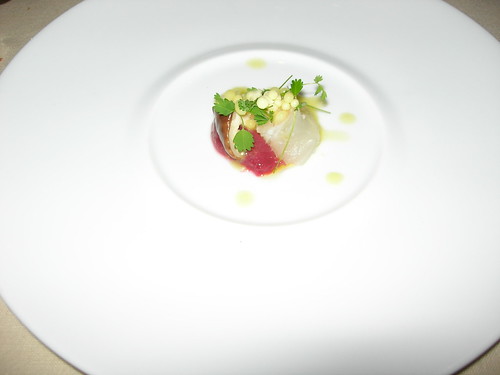
Our second dish borrowed from the vaults of WD-50. We were served Foie Gras with "Vinette" Jelly and Black Olive in Textures. The olive was what the downtown monde might call "olive soil" and "Vinette Jelly" was described as being from huckleberries, although traditionally the glaze is made from barberries. Although not busy, the flavors, herbaceous and fruity, created one of the more appealing foie gras dishes I have tasted this year. The olive soil did not seem like the conceit that it would have been elsewhere, but more a flavor enhancer, a reconsideration of salt and pepper.
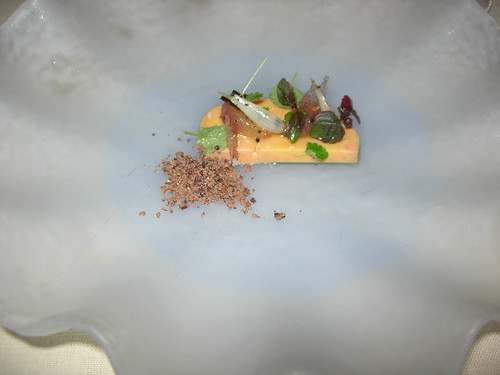
The third course played with the idea of foam. Chef Liebrandt served Lobster with Smoked Haddock Foam, Almond Croquant, and what was labeled "Jus Vert" (presumably verjus, liquid from unripe fruits such as grapes). Oddly the servers suggested that the Jus Vert were the bits of asparagus and snow peas hiding under the lobster. With fresh lobster, complications tend to overwhelm the simple crustacean's flavor. I would have been pleased without the haddock foam. Granted this was the only foam of the night, and young chefs need to be given their due, but lobster deserves a classical treatment.
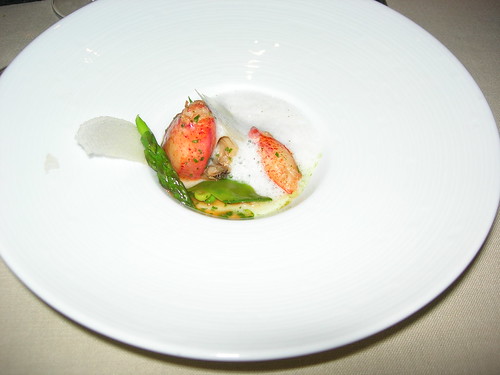
John Dory with Black Truffles, Green Mango ‘Gnocchi,' Cauliflower, and Periwinkles is a clever treatment of seafood. I was amused by the tiny ‘winkles winking as they surrounded the Dory, and found the green mango wittily constructed as a jellied square with a taste slightly reminiscent of wasabi. However, such a wee dish was undercut by the multiple tastes presented. Of all Liebrandt's dishes, this was the one that might have worked best if larger, when the several tastes could be appreciated on their own.
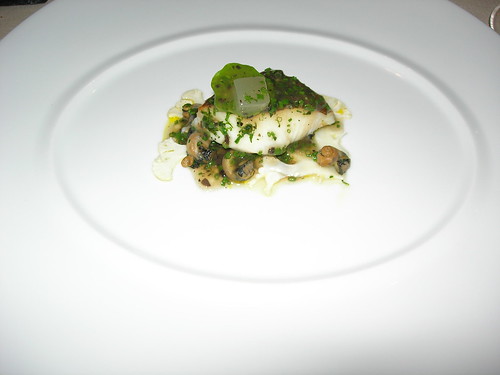
Prior to our poultry course, we were served a lovely sorbet, green apple and lemon verbena with extra-virgin olive oil, perched on an oyster shell. The touch of olive oil provided a depth of taste to the refreshing, straightforward sherbert.
Our main course was Poularde with Spring Garlic Purée and Artichoke Laqué (we were informed that the artichoke was pureed, rather than lacquered). The star of this dish was an elegant leaf of Chinese broccoli, a crisp and slightly sweet leaf that dominated the plate. Without this construction, I found the dish pleasant but lacking in memories. The chicken leg was cooked properly and the garlic and artichoke matched nicely, but, leaf aside, there was nothing startling.
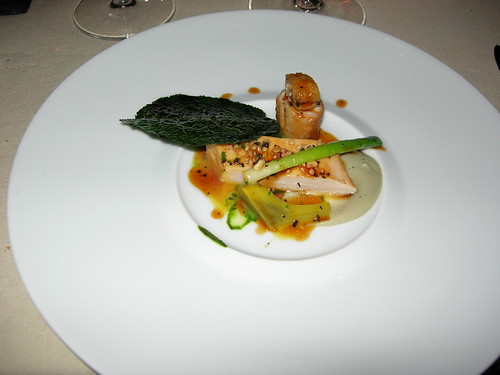
Perhaps the most experimental course was the trio of cheeses: Goat Cheese with Hazelnut Financier, Gruyere with a White Chocolate Wafer, and Stilton with Muscat Grapes and Cocoa Nibs (chopped cacao beans, separated from their husks). These small bites of cheese were presented microscopic style and were suitably crazed in their taste combinations. As short tastes, they effectively deconstructed a classical cheese course.
Next was a dessert of pure elegance: Lemongrass-champagne sorbet on white chocolate pudding with a bit of gold leaf on top - a fantasia of white and white. Such a clarifying dessert was most welcome.
I was less taken with the clementine gelée with toasted almond sabayon and lychee sorbet. The clementines that should have been the acidic center of the dish seemed wan and soggy. I'd was tempted to imagined them canned, but the almond sabayon was nicely constructed and the lychee sorbet pungent.
The final dessert was a degustation of chocolate, which my companion enjoyed. Avoiding caffeine, I was served a puzzling dessert, a lovely architectural conceit, but seemingly not as described. According to our server, I received a licorice charlotte (slabs of pineapple replaced the more traditional lady fingers) with rhubarb sorbet. Although the plate had a post-modern drizzle of deep black licorice syrup, I was perplexed by a pudding that had little licorice flavor, but tasted of cream and by a sorbet that seemed more yuzu than rhubarb. Perhaps by this point at night my tastes had dulled, but it was a singularly tame licorice. The dish was beautiful and nicely modulated, but a potent licorice charlotte would have been stirring.
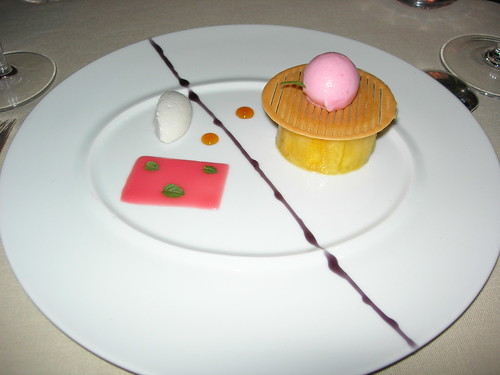
By the end of the meal, I discerned a weening desire to return. Although I admire Chef Liebrandt's vision, a tasting menu is not the best way to experience his skill. The dishes that were the most successful were those not jammed and cluttered. What was so impressive about Liebrandt's cuisine is that he doesn't experiment constantly, but realizes that a twist is sufficient to amaze. These twists are most startling in dishes where a diner was not faced with a new ingredient in each bite. Liebrandt is a chef whose creations deserve to be taken seriously and slowly: culinary foreplay before the climax.
Gilt
455 Madison Avenue (at 50th Street)
Manhattan (Midtown)
212-891-8100

No comments:
Post a Comment